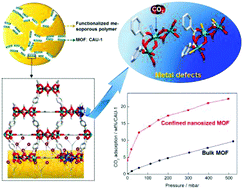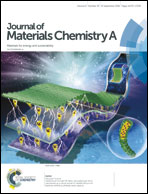A nanosized metal–organic framework confined inside a functionalized mesoporous polymer: an efficient CO2 adsorbent with metal defects†
Abstract
Hybrids with a nanosized metal–organic framework (MOF) confined within a mesoporous structure have attracted increasing attention owing to their enhanced mass transfer and novel applications. However, effective control of MOF crystal growth within pores and further understanding of the structure–property relationship are challenging. Herein, we report the confinement of a nanosized metal–organic framework CAU-1 into a functionalized mesoporous polymer via a combined impregnation and solvent vapor growth process. Carbonyl and hydroxyl groups over the wall of the mesoporous polymer well boost the nucleation and growth of CAU-1, leading to the formation of a nanosized MOF inside the mesoporous polymer. In contrast to bulk CAU-1, the nanosized CAU-1 within the hybrid exhibits significantly enhanced CO2 adsorption capacity at low pressure. As confirmed using the 27Al MAS NMR characterization technique, the confined nanosized CAU-1 is rich in aluminium defects. The improved CO2 adsorption properties probably result from the favorable diffusion kinetics and the presence of metal defects as active binding sites.



 Please wait while we load your content...
Please wait while we load your content...